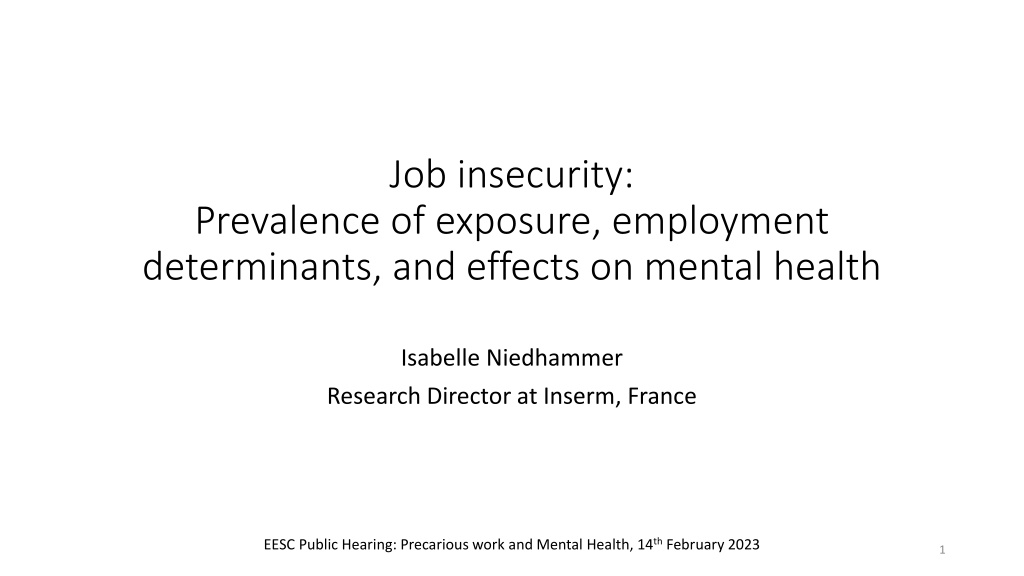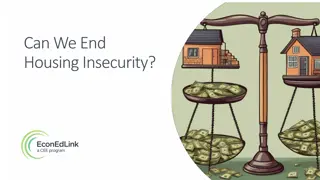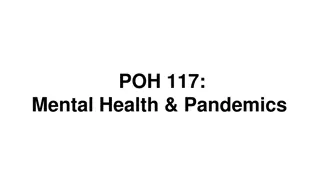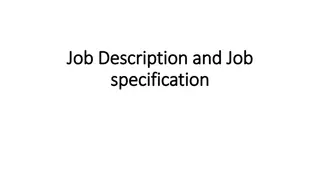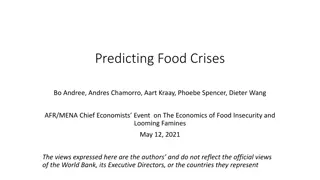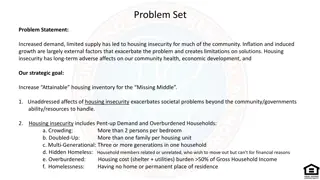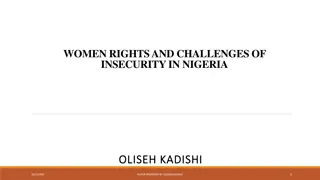Understanding Job Insecurity and Its Impact on Mental Health
Job insecurity is defined as the fear of job loss, a prevalent issue in Europe with significant variations between countries. Factors contributing to job insecurity include temporary work contracts, low education levels, and certain industries. Research shows a strong association between job insecurity and adverse mental health outcomes such as depression, anxiety, burnout, and even suicidal thoughts. These effects are consistent across different studies, highlighting the detrimental impact of job insecurity on individuals' well-being.
Uploaded on Oct 03, 2024 | 0 Views
Download Presentation

Please find below an Image/Link to download the presentation.
The content on the website is provided AS IS for your information and personal use only. It may not be sold, licensed, or shared on other websites without obtaining consent from the author. Download presentation by click this link. If you encounter any issues during the download, it is possible that the publisher has removed the file from their server.
E N D
Presentation Transcript
Job insecurity: Prevalence of exposure, employment determinants, and effects on mental health Isabelle Niedhammer Research Director at Inserm, France EESC Public Hearing: Precarious work and Mental Health, 14thFebruary 2023 1
Introduction and definition Job insecurity = fear of job loss Job insecurity precarious work/employment Job insecurity: a major psychosocial work stressor 3 reasons: Work = central role in people s life Job security = part of the psychological contract between employee and employer Job insecurity -> risk of unemployment and its detrimental consequences 2
Prevalence of exposure to job insecurity Europe 2015 (EWCS, Eurofound, Niedhammer et al. 2022) Fear of job loss in the next 6 months: 16.6% in 35 countries 15.7% in EU28 Significant differences between countries France 2013 (national working conditions survey) Fear of job loss in the next 12 months: 25.2% No gender difference 3
Employment determinants of job insecurity Temporary work contract Private sector Low educational or low occupational levels Manufacturing, construction Some employment determinants may be country-specific Other factors with inconsistent results: age, job seniority, full/part time work, company size 4
Effects of job insecurity on mental health (1) Results from literature reviews of epidemiological prospective studies Pooled estimates for the associations between job insecurity and mental health outcomes Ref Outcome Relative Risk (RR) 95% Confidence Interval Kim 2016 Depression 1.29 1.06-1.57 Ronnblad 2019 Depression 1.61 1.29-2.00 Ronnblad 2019 Anxiety 1.77 1.18-2.65 Aronsson 2017 Burnout 1.39 1.22-1.57 Milner 2018 Suicide ideation 1.91 1.22-2.99 Ronnblad 2019 Psychotropic medication 1.30 1.09-1.56 (Meta-review by Niedhammer et al. 2021) 5
Effects of job insecurity on mental health (2) Results from French prospective studies Job insecurity and depression and anxiety (2006-2010 SIP survey) RR (95% CI) Major depressive disorder Generalized anxiety disorder Men & Women 1.76 [1.17-2.64] 2.16 [1.47 -3.18] RR adjusted for covariates (Niedhammer et al. 2015) Job insecurity and poor well-being (2013-2016 national working conditions survey) RR (95% CI) Men Women Poor well-being 1.51 (1.11 2.05) 1.26 (1.03 1.53) RR adjusted for covariates (Bertrais et al. 2022) 6
Attributable fractions (AF) Definition: the fraction of disease cases that is attributable to an exposure in a population and that would not have been observed if the exposure had been non-existent (Nurminen and Karjalainen 2001) Fractions of depression attributable to job insecurity in Europe AF 95% CI % Total (35 countries) p-value Total (28 EU countries) p-value 9.19 * 8.76 ns [4.36-14.02] [4.13-13.40] Test of difference between countries (Niedhammer et al. 2022) 7
Conclusions Job insecurity Prevalent in most European countries, highly prevalent in some countries Major employment determinants of job insecurity identified Effects on various mental health outcomes Potential direct and indirect effects Need of more research and prevention in order to improve mental health at work 8
Main references Aronsson G, Theorell T, Grape T, Hammarstrom A, Hogstedt C, Marteinsdottir I, et al. A systematic review including meta-analysis of work environment and burnout symptoms. BMC Public Health. 2017;17(1):264 Bertrais S, H rault N, Chastang JF, Niedhammer I. Multiple psychosocial work exposures and well-being among employees: prospective associations from the French national Working Conditions survey. Scand J Public Health 2022;50:419-423 Kim TJ, von dem Knesebeck O. Perceived job insecurity, unemployment and depressive symptoms: a systematic review and meta-analysis of prospective observational studies. Int Arch Occup Environ Health. 2016;89(4):561-73 Milner A, Witt K, LaMontagne AD, Niedhammer I. Psychosocial job stressors and suicidality: a meta-analysis and systematic review. Occup Environ Med. 2018;75(4):245-53. Niedhammer I, Malard L, Chastang JF. Occupational factors and subsequent major depressive and generalized anxiety disorders in the prospective French national SIP study. BMC Public Health 2015;15:200 Niedhammer I, Bertrais S, Witt K. Psychosocial work exposures and health outcomes: a meta-review of 72 literature reviews with meta-analysis. Scand J Work Environ Health. 2021;47(7):489-508 Niedhammer I, Sultan-Ta eb H, Parent-Thirion A, Chastang JF. Update of the fractions of cardiovascular diseases and mental disorders attributable to psychosocial work factors in Europe. Int Archiv Occup Environ Health 2022;95:233- 247 Ronnblad T, Gronholm E, Jonsson J, Koranyi I, Orellana C, Kreshpaj B, et al. Precarious employment and mental health: a systematic review and meta-analysis of longitudinal studies. Scand J Work Environ Health. 2019;45(5):429- 43 9
